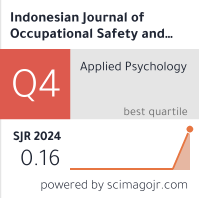RISK ASSESSMENT K3 PADA PROSES PENGOPERASIAN SCAFFOLDING PADA PROYEK APARTEMEN PT. X DI SURABAYA
Downloads
ABSTRACT
Problems that arised when employees works at height are worker did not wear full body harness, lanyard did not hanged perfectly to handrail, did not works according to the procedure, and using unsafe scaffolding. Hazard identification and risk assessment used as prevention for accident when operating scaffolding. This study was an observational study with cross sectional design and analyzed descriptively. The design used for the study carried out by observing cause and effect within a period of time and space. Objects of this study were frame scaffolding and scaffolding PCH, while subjects of this study were SHE Officer, SHE supervisor, workers section structure, finishing, plumbing hydrant, and mechanical engineering. Results of hazard identification using JSA method founds 43 potential hazards originating from 4 different types of work in this project. The results of the risk assessment of 43 potential hazards have been found that 1 hazard have low risk, 40 hazards have moderate risk , and high risk hazard are 2. The dominant risk from the operation of the scaffolding was 40 potential hazards or 93% of the total potential hazards and high-risk hazard eventhough only 5% of all potential hazards remains a top priority and should be controlled soon to reduce the high and medium risk becomes low risk. The likelihood-based control is more possible to reduce risk level than severity-based control.
Keywords: risk assessment, scaffolding operationBritish Standard Institute. Occupational Health and Safety Assessment (OHSAS) 18001:2007. 2007. England.
Dirjen PPK. 2004. Surat Keputusan Dirjen PPK No.20/DJPPK/2004 Tentang Sertifikasi Kompetensi Keselamatan dan Kesehatan Kerja Bidang Konstruksi Bangunan. Jakarta.
Kemenaker R.I. 1980. Permenaker No. 01/Men/1980 tentang keselamatan dan kesehatan kerja pada konstruksi bangunan. Jakarta.
Persada, Y. B. 2015. Hazard Identification and Risk Assessment (HIRA) Kecelakaan Kerja pada Proses Pengoperasian Scaffolding (Studi pada Proyek Apartemen PT. X di Surabaya). Skripsi. Fakultas Kesehatan Masyarakat Universitas Airlangga. Surabaya.
Prasetiyo, M.G.D. 2009. Gambaran Tingkat Risiko Bahaya Keselamatan Pekerja Kontraktor yang Menggunakan Scaffolding pada Renovasi Gedung PAU di Universitas Indonesia Tahun 2009. Skripsi. Fakultas Kesehatan Masyarakat Universitas Indonesia. Depok.
Pratiwi, S.D. 2009. Tinjauan Faktor-Faktor Perilaku Kerja Tidak Aman pada Proyek Pembangunan GOR Boker Ciracas PT. Waskita Karya Tahun 2009. Skripsi. Fakultas Kesehatan Masyarakat Universitas Indonesia. Depok.
Ramli, S. 2010. Pedoman Praktis Manajemen Risiko dalam Perspektif K3 OHS Risk Management. Cetakan Pertama. Dian Rakyat. Jakarta.
Susihono, W dan F. . Rini. 2013. Penerapan Sistem Manajemen Keselamatan dan Kesehatan Kerja (K3) dan Identifikasi Potensi Bahaya Kerja (Studi Kasus di PT. LTX Kota Cilegon- Banten). Jurnal Spektrum Industri 11(2): 117–242.
Wahyuni, I. 2010. Sistem Pengendalian Bahaya B e k e r j a p a d a K e t i n g g i a n d a l a m U p a y a Pencegahan.
Kecelakaan Kerja di PT. Gunanusa Utama Fabricators Serang Banten. Laporan Khusus. Program Diploma III Hiperkes dan Keselamatan Kerja. Surakarta.

In order to be accepted and published by The Indonesian Journal of Occupational Safety and Health, Author(s) who submit an article should complete all the review process. The copyright of received articles assigned to the The Indonesian Journal of Occupational Safety and Health and Department of Safety and Health, Universitas Airlangga as publishers of the journal. The intended copyright includes the rights to publish articles in various forms (including reprints).
The Editorial Team of The Indonesian Journal Of Occupational Safety and Health and Department of Safety and Health strive to ensure that no errors occur in the articles that have been published, both data errors and statements in the article.
Users of this website will be licensed to use materials from this website following the Creative Commons Attribution-NonCommercial-ShareAlike 4.0 International License. No fees charged. Please use the materials accordingly.
------------------------------------------------------------------------------------------------------------------------------------------------------------------------------------------
Attribution ” You must give appropriate credit, provide a link to the license, and indicate if changes were made. You may do so in any reasonable manner, but not in any way that suggests the licensor endorses you or your use.
NonCommercial ” You may not use the material for commercial purposes.
ShareAlike ” If you remix, transform, or build upon the material, you must distribute your contributions under the same license as the original.







 How to Submit Articles in OJS
How to Submit Articles in OJS

























